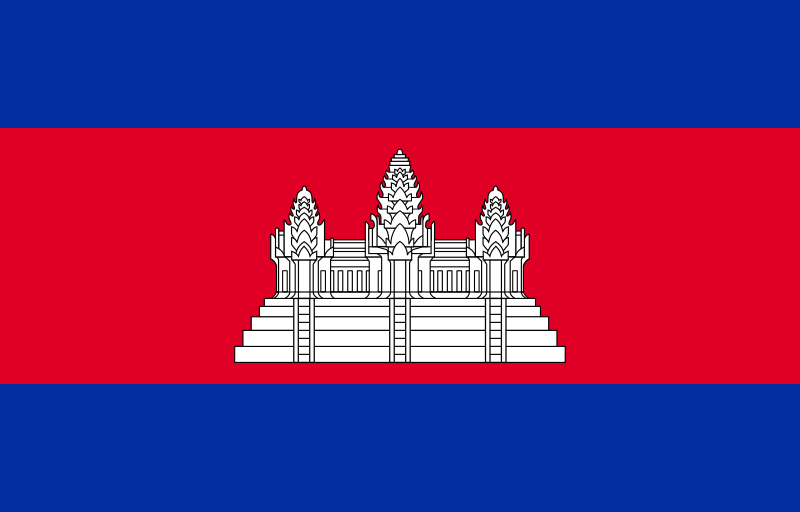Historical Evolution:
The flag of Cambodia stands as a visual tapestry woven with threads of the nation's intricate history and ever-evolving political landscape. It officially assumed its current form on June 29, 1993, a pivotal juncture marked by the restoration of the Cambodian monarchy and the establishment of a constitutional monarchy.
Colors Conveying Meaning:
This tricolored flag is a masterpiece in symbolism, with each of its horizontal bands meticulously chosen to represent profound concepts:
Blue (Top Stripe): A resplendent shade of blue adorns the flag's zenith, embodying the essence of Cambodia's regality and self-determination. This hue draws from a storied lineage, where blue was historically synonymous with the esteemed ruling class. It serves as an enduring tribute to the indomitable spirit coursing through the Cambodian populace, as well as a testament to their inherent strength and unwavering resolve.
White (Middle Stripe): Nurtured within the flag's middle expanse, a pristine white hue unfurls, epitomizing purity, truth, and harmony. This resplendent shade reflects the aspirations of a nation yearning for brighter tomorrows, after enduring decades of tumultuous conflict, civil strife, and the harrowing regime of the Khmer Rouge. The white stripe serves as an iridescent beacon, illuminating a path toward tranquility and unity.
Red (Bottom Stripe): The flag's base is adorned with a vibrant red, a color imbued with the valor, courage, and strength woven into Cambodia's narrative tapestry. This crimson stripe stands as a tribute to the sacrifices made by the Cambodian people across epochs of history, particularly during times of intense adversity, conflict, and the crucible of warfare. The red stripe bears witness to the nation's resilience and unwavering determination.
Intricacies of Design:
Nestled at the confluence of the blue and red stripes resides the national emblem, a tableau that encapsulates Cambodia's cultural and historical resonance.
Angkor Wat: Revered globally, the emblematic Angkor Wat takes center stage, intricately etched as a hallmark of Cambodia's cultural legacy. This sprawling, UNESCO-endorsed temple complex nestled in Siem Reap reverberates with architectural magnificence, adorned with intricate carvings that chronicle a rich past. The inclusion of Angkor Wat in the emblem acts as an eloquent ode to the nation's illustrious history, an emblematic link to its golden eras.
Symmetry and Unity:
The Cambodian flag adheres to the time-honored 2:3 aspect ratio, a configuration synonymous with national emblems. The trinity of horizontal stripes stand equal in stature, forming a harmonious backdrop to the central depiction of Angkor Wat.
Unifying Identity:
The Cambodian flag is more than a mere ensign; it is the very embodiment of a nation's pride and solidarity. Its resonance is profound, encapsulating the trials and triumphs of a people. It beckons forth a shared heritage, intertwining the threads of Cambodia's past, present, and an ardently envisioned future marked by prosperity and serenity.
In summation, the flag of Cambodia weaves together a saga of endurance, optimism, and cultural opulence. Through its chromatic symphony, design intricacies, and emblematic representation, it reverberates as an emblem of resilience, hope, and a shared cultural tapestry, enriching the hearts of the Cambodian people with a profound sense of identity and purpose.
Last Updated on: August 18, 2025
